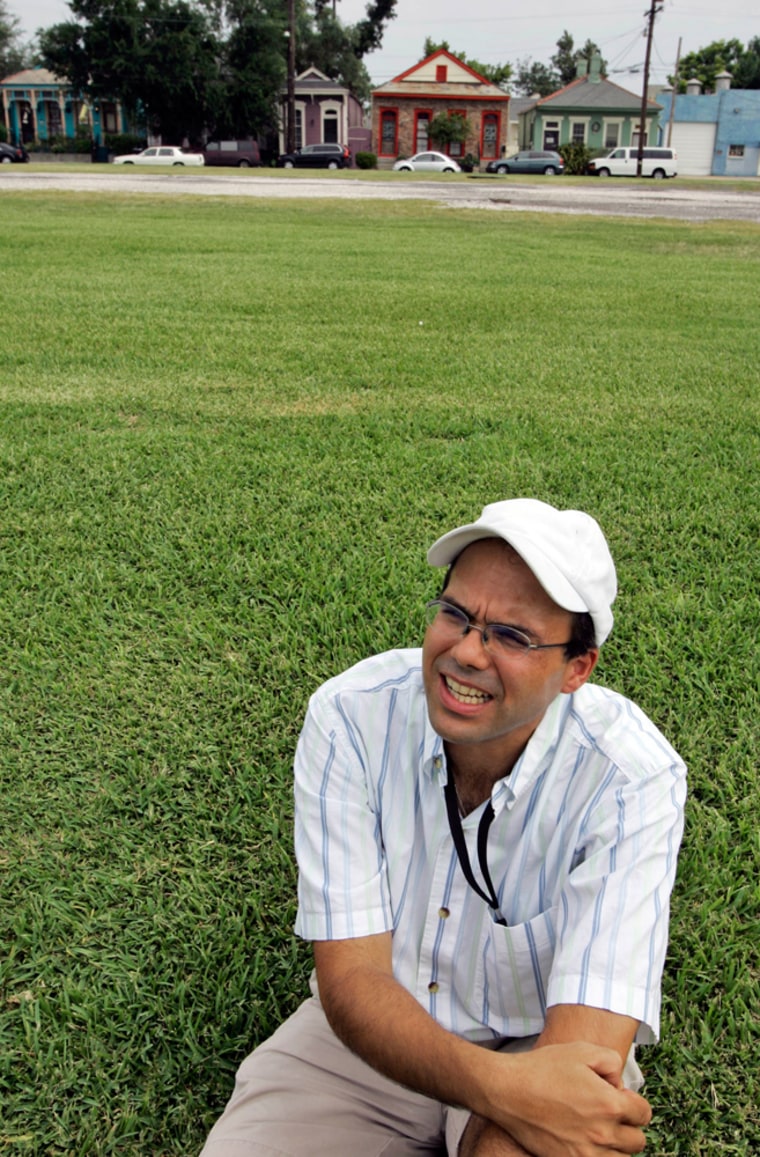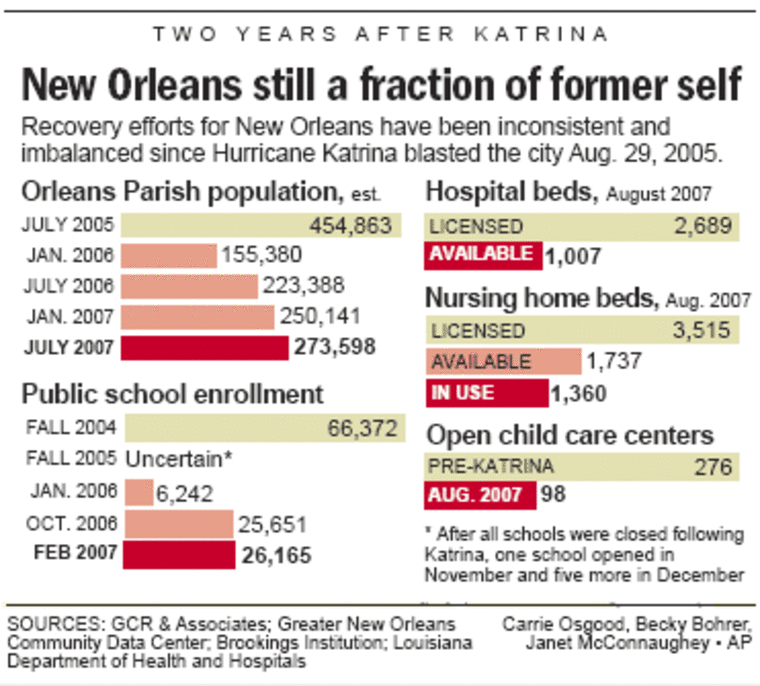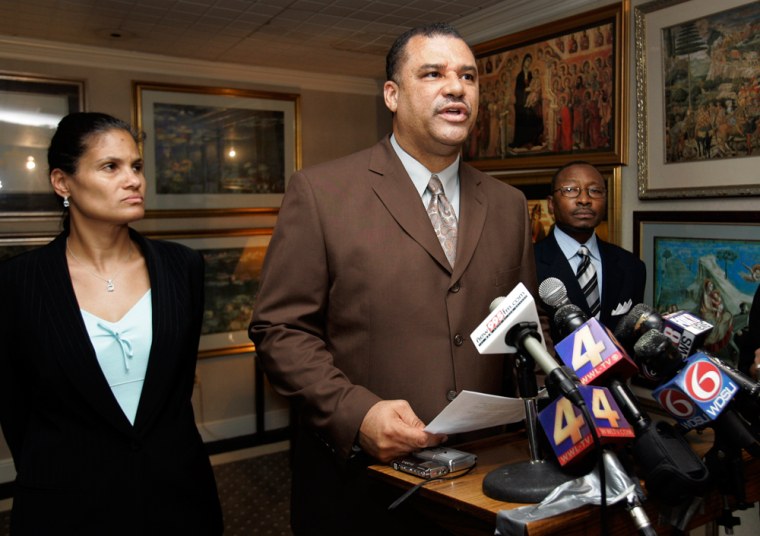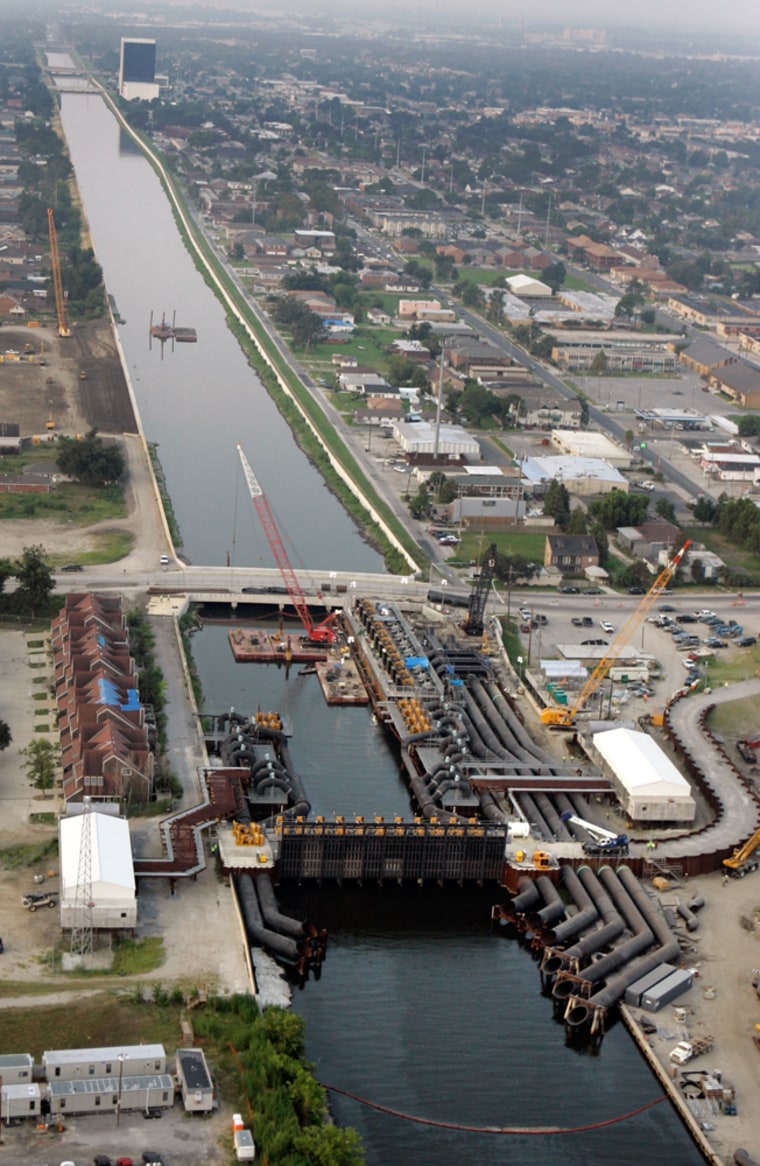Two years after Hurricane Katrina, much of the “city that care forgot” still lies in ruins. But Otis Biggs’ task as he shuffles his Tarot deck this moist August day is to peer into the future to 2015, the storm’s 10th anniversary.
Rings of silver and turquoise flash as one card, then another flops onto a zodiac-patterned table in the incense-perfumed Bottom of the Cup Tea Room in the French Quarter, where the diminutive Biggs has been telling fortunes for 32 years.
An upside down tower — violent storms will hold off until levees are repaired.
The ace of cauldrons — money will flow.
The empress — stability, fruitful things.
Downtown, near the riverfront, Biggs sees a gleaming glass and steel tower rising, the tallest in the state. Elections will bring new blood and vision. Companies will feel safe to invest in the city, and most of those who fled will return.
“There’s hope,” Biggs says, his hazel eyes twinkling in light reflected through a crystal ball.
Hope, but no promises
There may be hope, but there are few assurances for the recovering Big Easy.
“For every positive that’s going on in New Orleans right now, there’s a negative, there’s a concern,” says Reed Kroloff, who until recently was dean of the school of architecture at Tulane University.
The failure of federally funded, state-administered recovery programs to quickly take hold, and the city’s struggle to define and fund plans for neighborhood redevelopment, have shaken confidence about New Orleans’ short-term future. Mayor Ray Nagin favors a “market-driven” recovery of the city. Critics say he has not made the tough decisions necessary to get planning for the city’s future moving into high gear.
New Orleans still struggles with corruption. A congressman is under indictment, a senator has been implicated in a sex scandal and a city councilman thought to be a favorite as New Orleans’ next mayor pleaded guilty in August to federal bribery charges and resigned.
There are geophysical challenges ahead, too. By 2015, parts of New Orleans will have subsided nearly an additional 8 inches. The city filled up like a bowl when Katrina broke levees on Aug. 29, 2005. Roughly 240 more square miles of the eroding wetlands that protect the city from storm surge will be gone by 2015.
If the Army Corps of Engineers has its way, and billions in federal funds don’t get siphoned off by war or another natural disaster, those who remain should be better protected from flooding by 2015.
To the east, a massive levee-and-floodgate structure rising out of the brackish marsh should block the surge from the Gulf Intracoastal Waterway and the Mississippi River-Gulf Outlet, or MR-GO. To the north, new flood gates and pumping stations would prevent a surge from Lake Pontchartrain and prevent a repeat of the failures along the city’s drainage canals.
Population changes
The city’s population will be smaller a decade after the storm. A recent estimate pegs the current population at around 270,000 — about 60 percent of the pre-Katrina total.
Rich Campanella, an urban geographer at Tulane, predicts that by 2015, the city’s population will be somewhere around 350,000. Blacks will still outnumber whites, but the margin will be significantly less.

He and others agree the city’s residents will be somewhat more affluent, the poor possibly being squeezed out by the increased expense of living in a hurricane zone.
And New Orleans could be a city with a younger population.
“Not because there are more children,” says Campanella, associate director of the Center for Bioenvironmental Research at Tulane and Xavier universities. “Being elderly and in need of health care in this city might inspire many older people to relocate.”
Hospitals hemorrhaging money
Health care challenges and the dearth of affordable housing will continue to influence the pace of recovery.
Nearly half of the hospitals open in the parish before Katrina remain closed, and one is a shell of its former self. The remaining hospitals serving the city lost a combined $56 million in the first five months of 2007, and the projected operating loss for the year is $135 million, says Leslie Hirsch, who took over Touro Infirmary a week before Katrina.
If major changes aren’t made, such as drastic increases in Medicaid and Medicare reimbursement, the city’s hospitals will continue to hemorrhage money, says Hirsch, who worries there will be even fewer choices for care.
Before Katrina, many locals rented homes — garrets in the French Quarter, wings of faded mansions Uptown, shotgun homes in Bywater. For the impoverished, sprawling public housing projects offered shelter to more than 5,000 families.
But Katrina closed four-fifths of that subsidized housing.
The U.S. Department of Housing and Urban Development wants to demolish four of the biggest housing projects and turn them into Norman Rockwellian mixed-income neighborhoods. That plan has met with fierce opposition from housing advocates who fear the poor would lose their foothold.
And there’s little prospect New Orleans will become the renter’s paradise it once was.
The back wall of the city council chamber is lined with architectural renderings of mixed-income, multi-family developments. That is the future planned for the eight-story brick Falstaff brewery, where pigeons now roost and graffiti artists leave their marks.
But so far, those plans are little more than wrinkled drawings.
The future lies in the past?The city’s neighborhoods are repopulating, with and without government aid. But it is a patchwork redevelopment that favors those of means.
In the predominantly black Lower 9th Ward, the city’s poorest neighborhood, streetlights are back on and water is flowing. But while there are houses being repaired here and there, and even some innovative solar power projects being instituted, there are vast stretches of empty, weed-choked lots and rooftops still covered in storm debris.
In mostly white Lakeview, where water levels topped 10 feet in some areas, things are booming.
Harrison Avenue, the main business strip, is fairly buzzing with banks, restaurants, even a Starbucks. Medians once strewn with debris and rotting garbage are now blooming again with crepe myrtles.
Surveys show 47 percent of Lakeview residents have returned, and another 23 percent are working on their homes. Freddy Yoder, a recovery contractor, has not only refurbished his 11-year-old brick Queen Anne Victorian-style home, but he’s purchased several other lots in the neighborhood.

“I work with the Corps of Engineers. I go to their projects and I see what actions are being taken,” he says. “And I am thoroughly convinced that if we’re not there yet we’re very close to being in a very safe environment and a very safe place to live.”
Campanella, the Tulane geographer, thinks time, weather patterns and the insurance market will prove the folly of allowing people to reoccupy the city’s old footprint. He sees the future in New Orleans’ past.
Campanella says more than half of New Orleans is at or above sea level. But while nearly all New Orleanians occupied high ground a century ago, only 38 percent lived at or above sea level when Katrina hit.
Using satellite imagery, he has mapped about 2,000 empty or underutilized above-sea-level parcels covering an area about three times the size of the French Quarter.
“All I’m saying is we have this valuable natural resource that’s being underutilized,” he says, sitting in a grassy lot between two coffee warehouses in Faubourg Marigny.
Higher scores, but school challenges
And what happens with the public school system, long blamed as the root cause of New Orleans’ entrenched poverty, will also shape the city’s future.
Katrina accelerated a process of replacing the corrupt, underperforming system with reformed traditional schools and charter schools. Recently released test results show higher scores among the charter students. But the system is having trouble attracting teachers.
The clean slate attracted John Alford, a Harvard Business School graduate who moved from Baltimore to run the Langston Hughes Academy Charter School. By the storm’s tenth anniversary, he expects 90 percent of the city’s schools to be independently run charters.
“If we do what we’re supposed to do,” he says, “it can be a glorious city.”
Crime remains rampant. Meanwhile, the New Orleans Police Department is still operating out of trailers, and the force continues to lose more officers to retirement and resignations than it can graduate from its academy.
Changes in organization and funding of the criminal courts and public defenders’ offices promise to shore up a foundering judicial system. But with a nation-leading per-capita murder rate, the city has an uphill struggle to present an image of being safe.
Bittersweet tourism
Katrina continues to bring pain.
On a recent day, Stanley Joyce, 68, stood in line at City Hall with hundreds of others seeking to challenge their new property assessments. The valuation on his house just outside the French Quarter more than doubled. He knows the city needs the tax revenue. But that’s a lot to swallow all at once, especially in a city whose waterlines are crumbling and streets are riddled with tire-swallowing potholes.
“If they want to go ahead and buy my house for the price that they assessed it for, I’d sell it to them tomorrow,” said Joyce, waving a manila folder with his property records.
Tourism is a bittersweet bright spot. The French Quarter survived Katrina, and the music and restaurant scenes continue to rebound. Some musicians are still missing in action. But Jazz trumpeter Kermit Ruffins, a co-founder of the renowned Rebirth Brass Band, says he and friends are busy as ever.
“It’s just so wonderful to be alive and swinging in New Orleans,” he says. “We’re going to be buried here, man. That’s for sure. That’s for DAMN sure.”
Hotels, restaurants return
Most of the city’s signature restaurants — Brennan’s, Emeril’s, Commander’s Palace — have reopened.
A 70-story Trump hotel and condominium tower is planned for the central business district.
“There will be a Trump Tower,” Cliff Mowe, one of The Donald’s co-developers, said last week during a visit to the city for meetings with project attorneys and real estate people.
The building is not scheduled for completion until 2010, but Mowe says developers have received several hundred reservations and deposits from prospective tenants — many for units costing nearly $2 million.
But as millionaires stake out lofty digs, the city continues to bleed jobs. Tourism is notoriously poor-paying. There are huge questions about where thousands of good-paying jobs needed to sustain the city’s rebound will come from.
Future safety questionable
Since Katrina, the oil industry has continued a shrinking that began in the 1980s. In November, Murphy Oil Corp. closed its New Orleans production office and shifted 100 employees to Houston. Chevron Corp. is building a new office across Lake Pontchartrain in St. Tammany Parish and will move 500 workers from New Orleans later this year.
Entergy Corp. was and likely will remain the city’s only Fortune 500 company, says Robert Hartwig, chief economist at the Insurance Information Institute. “It’s unlikely that it’s going to emerge ... as a major business center,” he says.

That means the city’s economy will muddle along, bouyed by short-term construction jobs and spending. For the economy to prosper long-term, the city must be seen as safe and well-run.
And there, the jury is out.
Local businessman Aidan Gill doesn’t need Tarots or tea leaves to know what New Orleans will look like in 2015. All he has to do is read the local newspaper and history books: It’ll be just as corrupt and seedy as before Katrina, he believes.
“I am mystified at grown-up, mature, intelligent, educated people for talking about this ‘new New Orleans,”’ says the Irish native, who dispenses $45 haircuts and $600 alligator belts from his men’s haircuttery and haberdashery on Magazine Street.
“A simple way of putting it for the simple natives: You cannot make a gumbo using the same ingredients every day, and then at the end of every day expect it to taste any different.”
